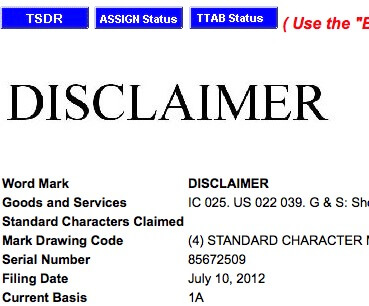What Is a Trademark Disclaimer?
If you are reading this, you likely have an office action that requires a trademark disclaimer. A disclaimer is a common thing in trademark law. However, the Trademark Office will not approve a trademark application until the applicant disclaims a portion of the mark.

A trademark disclaimer is a written statement that “disclaims” “exclusive rights” to “unregisterable content” in a “trademark registration”.
Disclaimers protect the public’s First Amendment right to use words that are considered public domain. This right extends to the use of generic or descriptive words and phrases. In other words, Disclaimers deny trademark owners from claiming exclusive rights to these type common descriptive or generic words and phrases.
1. To Disclaim – disavow – deny ownership of Exclusive Rights to Unregisterable Content
A disclaimer is an affirmative declaration that is a public record. The declaration states that a trademark registration does not have “exclusive rights” to the disclaimed content. In other words, it is an affirmative denial of ownership to rights in the particular word, phrase, or graphic.
2. Exclusive Rights
A registered trademark is a government granted monopoly. This is because it provides the owner with an exclusive right to use the mark in connection with the registered goods/services. However, a disclaimer is an exception to the exclusive rights. This is becasue it excludes the exclusive rights for parts of the trademark that are generic or descriptive.
3. A Disclaimer Only Limits Rights Conveyed by the Trademark Registration – Common Law Trademark Rights Are Unaffected.
Trademark law is a two-part system that operates in parallel. One system involves rights through a trademark registration with the U.S. Patent & Trademark Office. The second system is Common law rights. When applied, Common law trademark rights exist regardless of a trademark’s registration status. A plaintiff may proceed under either or both systems.
A trademark disclaimer limits only statutory rights granted by the trademark registration – not common law trademark rights. 15 U.S.C. 1056. However, because the disclaimer does not deprive plaintiff of common law rights it may have in the disclaimed content, plaintiff may assert infringement of those rights.
There is no guarantee that plaintiff will fare any differently under common law rights. After all, the Trademark Office, is an expert in the field that found the disclaimed content unregisterable. Consequently, a court looking at the common law issue, will likely find the content equally unprotected. The substance of the rules for finding unprotected or unregisterable content do not change.
What does “apart from the mark as shown” Mean in a Trademark Disclaimer?
Apart from the mark as shown means that the Trademark Registration conveys rights in the entire mark. That is, the rights extend to both the protectable and the disclaimed components.
If the mark includes an unregisterable component, then the government makes you disclaim the exclusive right to part of the trademark. So, when combined as a whole, you get rights to the protectable and unregisterable parts of the trademark. The disclaimer’s job is to make it clear that there is no claim to the unregisterable component.
There are multiple reasons why a mark needs a disclaimer. For example, there must be a disclaimer if a mark is generic, descriptive, geographically descriptive mark, or laudatory words.
Disclaimer of Generic Elements of a Trade Mark
A generic mark refers to the category of a product or service. Ironically, the more successful the trademark, the less protection it will receive. The owner loses its exclusive rights to its trademark when it becomes generic.
A trademark can become generic if the mark becomes synonymous with a product or service. This is measured by what the public’s mind associates with a particular word. For example, the word Kleenex became the same a tissues. Another example is Aspirin being synonymous with a pain-killer.
Disclaimer of Descriptive Elements of a Trademark
A descriptive mark occurs when the mark describes a good or a service. Merely descriptive marks can only receive trademark protection in the U.S. if they achieve something called a “secondary meaning.”
For example, in re Brown-Forman Corporation, it was found that the words ROGUE was descriptive. Accordingly, when consumers come across GALA ROUGE wine, they will view GALA as the brand name, and ROUGE as the color of the wine.
Disclaimer of Geographically Descriptive Elements of a Trademark Application
Words or designs that describe the origin of your goods or the location of your services must be disclaimed. For example, Alaska in Alaska Air would need to be disclaimed.
Trademark Disclaimer of Laudatory Words
Laudatory words relate or express praise to a company or trademark. This includes phrases like “The Best Ever.”
Disclaimer: This information is for educational purposes, and is not intended to be legal advice. Each case turns on its own facts. Please consult with an experienced trademark attorney.
EsquireTrademarks.com – Online Trademark Attorneys – What We Do:
Our trademark attorney, prepares and files trademark applications for clients throughout the United States and abroad.
We prosecute and defend trademark infringement and unfair competition actions in the Federal Courts throughout the United States and abroad. Additionally, our office prosecute trademark office actions and appeals before the United States Trademark Office. We also handle internet based trademark disputes and trademark, DMCA, and copyright takedowns. Further, we draw on our experience as trademark litigators to guide you through the trademark process. Lastly, we support businesses, law firms, and individuals by providing top notch legal services in intellectual property matters.
